#style: prêt-à-porter
Explore tagged Tumblr posts
Text
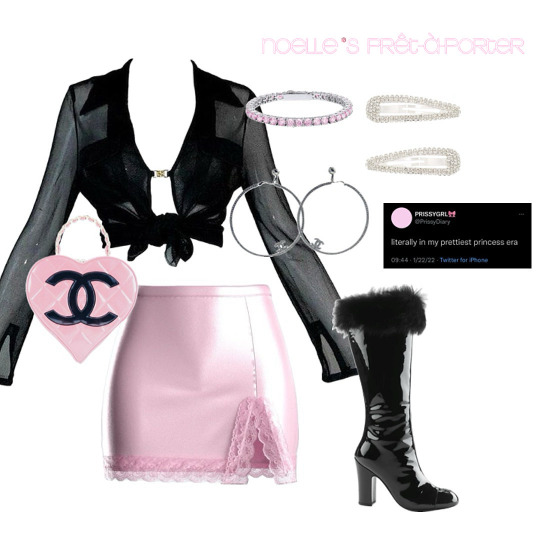
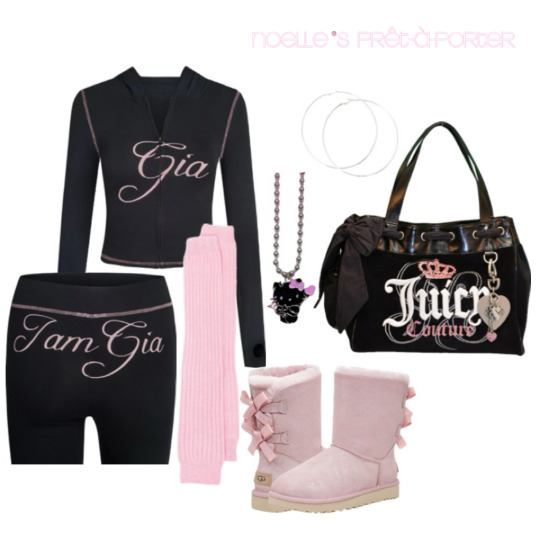
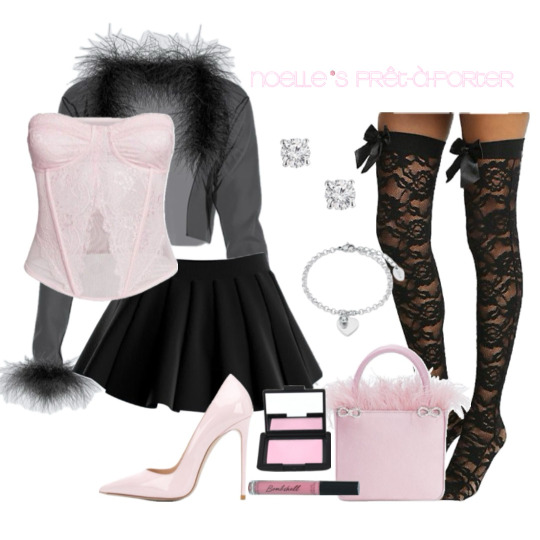

fashion styling is a passive form of therapy for me 🐈⬛💓
623 notes
·
View notes
Text


(UTA) Stewardess uniform 1968 by Pierre Cardin
(Extrait de Fashion In Flight: A History of Airline Uniform Design)
#pierre cardin#1968#fashion 60s#uta#stewardess#hôtesse de l'air#style 60s#cabin crew#ready to wear#prêt à porter
21 notes
·
View notes
Text


'baroque-style necklace created for gianfranco ferré's prêt-à-porter show, a/w 1985-6' in fashion jewellery made in italy - deanna farneti cera (2013)
154 notes
·
View notes
Text
Nadja Auermann, 1996. Givenchy Prêt-à-porter by John Galliano.
Scanned from “Her Style: Hair By Odile Gilbert,” 2003



46 notes
·
View notes
Text
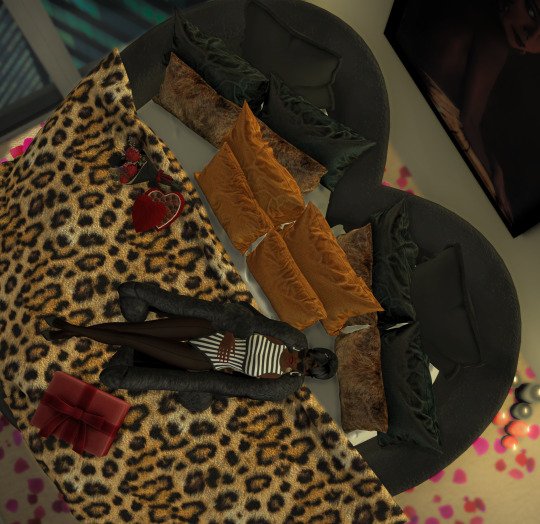
BHM 2025 - Black Fashion Figures: Patrick Kelly, Part 1
Disclaimer: Today's figure is a bit controversial, and I'm not gonna lie, I hesitated to add him. However, while I don't fully agree with his approach, his career and designs bring up valid discourse. Additional thoughts will be brought up in part 2.
Patrick Kelly (1954-1990) was born in Vicksburg, Mississipi. Raised by his grandma in the Deep South, his childhood greatly influenced his career trajectory and designs. In fact, he credits his grandma's style and her frequent addition of mismatched vintage buttons to his clothes as key inspirations for his designs. He started designing items for his friends, before moving to Atlanta in 1974 to open a small boutique, upcycling vintage garments and luggage. Kelly's love and appreciation for vintage is relevant here, as he went on to collect golliwog dolls and blackface paraphernalia. He went as far as making the dolls' blackface his namesake brand's logo.
In 1980, model Pat Cleveland offered him a first-class ticket to move to Paris, where he took the city by storm. Cleveland was one among many models and figures with whom he built a close relationship thanks to his Southern charm and hospitality. His ability to foster community wherever he went granted him opportunities, ranging from receiving a portable sewing machine to make his first collection, to meeting the Neimann Marcus buyers who purchased that same collection. At a time where Japanese designers and their minimalist cerebral designs were the talk of the town, Patrick Kelly's designs were playful, colorful, and edgy all while maintaining some classic elements and remaining beautifully crafted. This helped him appeal to a broad range of consumers, from the likes of Princess Diana and Grace Jones, to your everyday corporate workers. Patrick Kelly's brand was not only financially successful, but he also gained meaningful recognition in France, becoming the first African American to be introduced to the Chambre Syndicale du Prêt-à-Porter des Couturiers et des Créateurs de Mode.
Thanks to all the CC creators: @candysims4, @madlensims, @donotdoubt
Sources and more under the cut.
Sources:
Fashion the Self: From Vicksburg to Paris and Aesthetic Literacy
1954-1990 – Patrick Kelly
Fashion Designer Patrick Kelly Dies -- Paris-Based Industry Welcomed American Of Humor, Imagination
In Paris, His Slinky Dresses Have Made Mississippi-Born Designer Patrick Kelly the New King of Cling
Patrick Kelly: Reclaiming Racist Memorabilia
Patrick Kelly: Fashion, Life, and Legacy
Working It: Supermodels and Superstars Remember Patrick Kelly
Reference photo:
1
9 notes
·
View notes
Text
Fashion & Manufacturing
Fashion & Trends:
Fashion is the art and industry of style, clothing, accessories, makeup, and lifestyle expressions. It reflects cultural, social, and individual identity—constantly evolving with time, technology, and taste.
What is Fashion? Fashion refers to popular styles or practices, especially in clothing, footwear, accessories, and makeup. It is influenced by celebrities, designers, social media, movies, culture, and current events. Fashion isn't just about what you wear — it's about how you wear it, expressing mood, identity, or status.
What are Trends? Trends are short- to medium-term shifts in what people wear or how they dress. Trends can be: Seasonal: Spring/Summer, Fall/Winter Micro-trends: Viral styles lasting weeks/months (e.g., Barbiecore) Macro-trends: Long-term shifts (e.g., sustainability, gender-neutral fashion)
Sources of Fashion Trends
Fashion Weeks (Paris, Milan, New York, London)
Influencers & Celebrities
Social Media (Instagram, TikTok, Pinterest)
Street Style
Pop Culture (Movies, music, TV)
Technology (e.g., wearable tech, digital fashion)
Examples of Recent Fashion Trends (2024-2025)
Y2K revival: Low-rise jeans, crop tops, shiny fabrics Sustainable fashion: Upcycling, natural dyes, eco materials Gender-fluid clothing: Unisex cuts, neutral colors Quiet luxury: Minimal, high-quality clothing (less logos, more elegance) Statement accessories: Oversized earrings, platform shoes, chunky bags
Fashion Categories Haute Couture: Custom, high-end fashion Ready-to-Wear (Prêt-à-Porter): Designer fashion sold in stores Streetwear: Youthful, casual, culture-driven fashion Fast Fashion: Mass-produced trends, affordable (but criticized for waste)
3 notes
·
View notes
Note
Why don’t you post your outfits that much
no specific reason but most times i really don’t think to take pics of how i style myself. i just post them on “noelle's prêt-à-porter 🎀” or it’s just a chill athleisure kinda day. this may change though since i’m doing youtube again.
10 notes
·
View notes
Text
New Exhibition Explores the Timeless and Perplexing Tradition of “Trompe l’Oeil”
by Eva Baron - My Modern Met, May 12, 2025

George Ayers, “Swamp Frog,” oil on panel
Much like a puzzle, an illusion demands patience. But it also rewards that endurance, offering, in return, a complete story from its singular and sometimes baffling parts. Fool Me Twice, a new exhibition staged at Robert Lange Studios (RLS), sets up such an agreement: visitors may initially be perplexed by these visual tricks, but those determined enough will decipher them—and to great satisfaction.
Encompassing 20 artists from around the world, Fool Me Twice celebrates the artistic tradition of trompe l’oeil, often translated as “deceive the eye” in English. As its name suggests, the technique relies heavily upon illusion, blurring the boundaries between reality and representation. These artists seem to ask What do we believe to be real? and How confident are we in defending those beliefs?
If the paintings in Fool Me Twice are any indication, we should be wary and perhaps even suspicious of what we encounter. George Ayers, for instance, beckons viewers toward Swamp Frog, in which a hyperrealistic frog seems to be breaking through the surface of the canvas. His Wall Tart composition, on the other hand, mimics a decadent slice of cake tearing through a plaster wall.
“I wanted to create something that makes people question the limits of the painting itself,” Ayers said in a statement. “The frog isn’t just painted on the surface—he’s breaking through it, challenging what’s real and what’s illusion.”
Sharon Moody’s The Year of Great Shocks achieves a similar effect, showcasing a comic book splayed out to reveal a spread in which New York City is swamped with water. The pages appear so weathered, so delicately thin, that it feels almost impossible to resist the urge to flip through the book, exploring what other shocks it contains. But resist the urge we must—the comic book is, in fact, meticulously painted onto a canvas.
Other works in Fool Me Twice pay homage to the early pioneers of the genre. Lange, who owns RLS but is also a realist painter, contributes Illusions Within, featuring an iPhone whose background is René Magritte’s The Son of Man. During his lifetime, Magritte was renowned for his surreal, illusory style, one that can be succinctly described through his iconic painting The Treachery of Images.
To echo Magritte, is a painting of a pipe really a pipe? Fool Me Twice doesn’t propose an answer, but it does exemplify the joys of posing such a question in the first place. The exhibition’s artworks are certainly rigorous in their technical accomplishments, but it’s their insistence on wonder and mystery that truly set them apart.
Fool Me Twice is currently on view at Robert Lange Studios in Charleston, S.C., through May 25, 2025.

Sharon Moody, “The Year of Great Shocks,” oil on panel

Daniel Caro, “Prêt-à-porter,” oil on panel

Joel Carson Jones, “Inside Out Outside In,” oil on panel

Leeah Joo, “Parrhasius No. 62, Cranes,” oil on panel

Robert Lange, “Illusions Within,” oil and vinyl on panel

Natalie Featherston, “Nested,” oil on panel

Natalie Featherston, “Nested,” oil on panel

Jacob A. Pfeiffer, “In a Bind,” oil on panel

Patrick Nevins, “Halcyon,” oil on panel
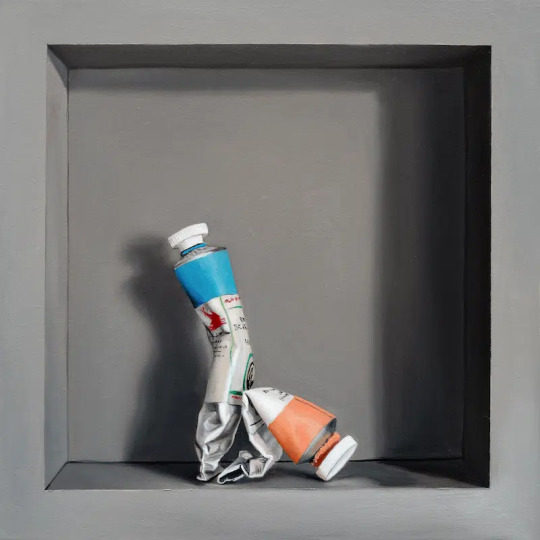
Robert Lange, “Bend and Blend,” oil on panel
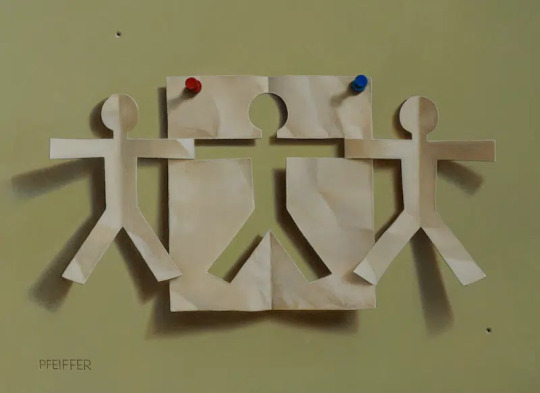
Jacob A. Pfeiffer, “Middleman,” oil on panel
Robert Lange Studios: Website | Instagram
2 notes
·
View notes
Text
Fashion: The Ever-Evolving Art of Style and Expression
I. Introduction to Fashion
Fashion is a powerful form of self-expression, culture, and creativity. It extends far beyond clothing, influencing how individuals present themselves to the world and how society perceives style and identity. From ancient civilizations to modern runways, fashion has continuously evolved, reflecting historical, social, and technological advancements.
At its core, fashion encompasses clothing, accessories, footwear, and even behavior influenced by cultural trends. It is an industry worth billions, shaping economies, celebrity lifestyles, and even sustainability efforts in recent years. More than just a way to dress, fashion is a statement—whether it signifies social class, personal style, or artistic expression.
This article delves deep into the world of fashion, exploring its history, various types, cultural significance, industry leaders, sustainable trends, and its promising future in the digital age. Whether you are a fashion enthusiast, a designer, or simply someone who enjoys stylish clothing, this comprehensive guide will provide you with an insightful look at the ever-changing world of fashion.
II. History of Fashion
1. Ancient Fashion
Fashion dates back thousands of years, with early civilizations using clothing as both protection and a symbol of status.
Egyptians: Linen garments, elaborate jewelry, and headdresses symbolized wealth and power.
Greeks and Romans: Draped tunics like the toga, often made from wool and silk, signified different social classes.
2. Medieval and Renaissance Fashion
During the Middle Ages, fashion became more elaborate with embroidered garments, layered clothing, and accessories. The Renaissance brought luxurious fabrics, intricate patterns, and a focus on artistic craftsmanship.
3. Industrial Revolution and Modern Fashion
The Industrial Revolution enabled mass production of clothing, making fashion accessible to the middle class. By the 20th century, fashion evolved rapidly with each decade bringing distinct styles—from the flapper dresses of the 1920s to the grunge aesthetic of the 1990s.
III. Types of Fashion
1. Haute Couture
Haute couture represents high-end, custom-made clothing crafted by designers like Chanel and Dior, catering to elite clientele.
2. Ready-to-Wear (Prêt-à-Porter)
This category includes designer collections that are mass-produced but still maintain exclusivity.
3. Fast Fashion
Fast fashion brands like Zara and H&M rapidly produce trendy, affordable clothing inspired by runway designs.
4. Sustainable Fashion
With growing concerns about environmental impact, sustainable fashion focuses on eco-friendly materials and ethical production.
IV. Fashion Trends Over the Decades
DecadeKey Trends1920sFlapper dresses, cloche hats1950sElegant dresses, fitted suits1970sBell-bottoms, hippie fashion1990sGrunge, minimalism, crop tops2020sStreetwear, digital fashion, sustainability
V. The Role of Culture in Fashion
Fashion is deeply rooted in culture. Traditional clothing like the kimono (Japan), saree (India), and kilt (Scotland) showcase national heritage. Globalization has led to cultural fusion, influencing international fashion trends.
VI. Fashion and Self-Expression
Clothing choices reflect personality, confidence, and individuality. Whether it’s streetwear, bohemian, or classic chic, fashion allows people to communicate who they are without words.
VII. Major Fashion Capitals of the World
These cities are trendsetters in the global fashion industry:
Paris – Home to luxury brands like Louis Vuitton and Chanel.
Milan – Italian craftsmanship and high fashion.
New York – A blend of urban and high fashion trends.
London – Known for edgy and avant-garde fashion.
Tokyo – Innovative and experimental fashion scene.
VIII. Fashion Industry and Its Key Players
Fashion is driven by:
Designers (e.g., Karl Lagerfeld, Alexander McQueen)
Luxury Brands (e.g., Gucci, Prada, Nike)
Fashion Houses (e.g., Balenciaga, Givenchy)
Influencers & Bloggers who shape modern trends
IX. Sustainable Fashion and Ethical Practices
The fashion industry is shifting towards sustainability with:
Eco-friendly fabrics like organic cotton and recycled polyester
Ethical production ensuring fair wages and humane working conditions
Slow fashion promoting quality over quantity
X. The Influence of Celebrities and Social Media on Fashion
Social media and celebrity culture shape fashion trends. Platforms like Instagram and TikTok make styles go viral overnight, while celebrities set trends through red carpet appearances and collaborations with brands.
XI. Fashion Accessories and Their Role
Accessories like handbags, shoes, jewelry, and watches elevate outfits. Iconic brands such as Hermès (Birkin bags) and Rolex (luxury watches) define high-end accessories.
XII. Seasonal Fashion Trends
Fashion adapts to seasons:
Spring/Summer: Light fabrics, floral prints.
Fall/Winter: Layering, wool, leather.
XIII. Men’s vs. Women’s Fashion
Fashion trends differ across genders, but gender-neutral clothing is on the rise, blurring traditional boundaries.
XIV. The Future of Fashion
Technology is revolutionizing fashion with:
AI-generated designs
Virtual fashion shows
Metaverse clothing and digital wearables
XV. Conclusion
Fashion is an ever-changing industry that reflects culture, technology, and individual expression. Whether inspired by history, personal style, or innovation, fashion continues to evolve and influence society on a global scale.
FAQs About Fashion
1. What is the difference between fast fashion and sustainable fashion?
Fast fashion prioritizes affordability and trend replication, while sustainable fashion focuses on ethical production and eco-friendly materials.
2. Why is Paris considered the fashion capital?
Paris is home to luxury fashion houses, iconic runways, and historical fashion influence.
3. How do celebrities influence fashion trends?
Celebrities set trends through brand collaborations, social media, and red carpet appearances.
4. What are must-have fashion accessories?
Classic handbags, timeless watches, statement sunglasses, and trendy sneakers.
5. What is haute couture, and why is it important?
Haute couture represents the pinnacle of craftsmanship with custom-made, high-fashion garments.
6. How is technology changing the fashion industry?
AI, 3D printing, and virtual fashion are reshaping fashion design and retail.
5 notes
·
View notes
Text
Comment porter les bottes de cowboy : Le guide complet
Salut à toi, fan de l'univers cowboy ! Tu te demandes comment porter les bottes de cowboy avec style ? Tu es au bon endroit. Que tu sois un homme ou une femme, je vais te donner tous les conseils nécessaires pour intégrer ces bottes western dans tes tenues du quotidien. Prêt à te transformer en véritable cowboy moderne ? Allons-y !
Pourquoi choisir les bottes de cowboy ?
Les bottes de cowboy, ou santiags, ne sont pas seulement pour les rodéos ou les ranchs au Texas. Elles sont devenues un véritable symbole de mode western et peuvent s'intégrer parfaitement dans différentes tenues pour un look audacieux et tendance. Que tu admires des icônes comme John Wayne, Calamity Jane, ou des stars contemporaines comme Kendall Jenner, les cowboy boots sont un incontournable.
Comment porter les bottes de cowboy avec style
1. Avec un jean : la combinaison classique
Pour un look authentique, rien de mieux que de porter tes bottes cowboy avec un jean. Opte pour un jean slim ou droit, et assure-toi qu'il est assez long pour couvrir les bottes sans traîner par terre. Pour un style décontracté, tu peux aussi rentrer le bas du jean dans tes bottes.
2. Avec une robe : pour les femmes audacieuses
Les bottes western femme s'accordent parfaitement avec une robe. Pour un look bohème, choisis une robe fluide et légère. Pour un look plus rock, une robe en cuir fera l'affaire. Les bottes de cowboy ajoutent une touche de caractère à n'importe quelle tenue féminine.
3. En automne-hiver : reste stylé même par temps froid
Les bottes cowboy sont idéales pour l'automne-hiver. Porte-les avec un manteau long et un chapeau de cowboy pour un look complet. Les bottes en cuir sont particulièrement adaptées à cette saison, car elles sont robustes et chaudes.
4. Pour un look casual-chic : joue sur les contrastes
Associe tes bottes cowboy avec une chemise blanche et un blazer pour un look casual-chic. Cette combinaison fonctionne aussi bien pour les hommes que pour les femmes. Les bottes western ajoutent une touche de décontraction à une tenue élégante.
Les erreurs à éviter
Pour bien porter les bottes de cowboy, voici quelques erreurs à éviter :
Trop de western tue le western : Évite de surcharger ton look avec trop d'éléments western. Les bottes suffisent à elles seules pour donner le ton.
Des bottes mal ajustées : Assure-toi que tes bottes sont bien ajustées. Elles ne doivent ni être trop serrées, ni trop larges.
Négliger l'entretien : Les bottes en cuir nécessitent un entretien régulier pour rester belles et confortables.
Des inspirations pour tous les goûts
Inspire-toi des stars qui savent comment porter les bottes de cowboy avec classe :
Emily Ratajkowski et Olivia Frances Culpo : Ces icônes de mode maîtrisent l'art de porter des bottes western avec des tenues modernes.
Kate Middleton et Isabel Marant : Elles montrent comment intégrer des bottes cowboy dans des looks élégants et sophistiqués.
Conclusion
Porter des bottes de cowboy peut transformer n'importe quelle tenue en un look audacieux et stylé. Que tu optes pour un jean, une robe, ou un look casual-chic, les bottes cowboy sont un atout mode incontournable. Alors, prêt à adopter le style western ? Choisis ta paire de bottes cowboy, et montre au monde entier que tu es un véritable cowboy des temps modernes !
Si cet article t'a plu, n'hésite pas à le partager et à laisser un commentaire. À bientôt, cowboy !
#cowboy hat#cowgirl#cowboy#comics#cars#aesthetic#crafts#celebs#black cats#1950s#60s#70s#80s#across the spiderverse#alternative#animals#animation
2 notes
·
View notes
Text

Riccardo Tisci -Givenchy
SS09 interview
"Since we heard that you had assigned for Men's Director, we had been looking forward to see your collection. The show was great and fabulous, and also completely different uses of imagination from the previous season.
01.
-Please tell us how you thought about designing this Men's Collection for the first time this season
I am very happy because what I wanted to do was to do something very me. I treated it as if it was my first kid. And I am very happy for the people that believed in my creativity until now...
02
Please tell us which part did you put the most effort in this collection.
I wanted to give my best without looking like someone else's collection; I found out menswear wardrobe was either too casual or too elegant, so I decided to do something in between. While you only have skinny and androgyny looks around, I played with healthiness, masculinity, volume, and more sensuality on menswear.
03.
You are now designing three collections for Givenchy: Prêt-à-Porter, Haute Couture, and Men's. Can you tell us the good part or the hard part for designing three different collec tions?
"Givenchy man is the boy friend of Givenchy woman". This is the major premise that reinforces the image of Givenchy brand by providing greater coherence. It can not be made possible without my experience as a designer in the world of womenswear. There is no demerit. Designing makes my life, and it is what makes me happy. To me, the designing is a way to express myself to the public.
04.
-How is the approach different in the designing Men's and Ladies Collection? And where the inspirations come from?
There are a lot of differences between Men's and Women's...A woman wants radical changes every season. But for a man, when they find their own shapes, styles and images, they love it and stay faithful to it forever. I don't have much interest in classic aesthetic stan dards and I think we all have to get out of syn drome you often see today that requires men and women to have very skinny links. The two collections have a lot in common because they are from the same thought.
05.
-Please tell us what the most important factor is for men's fashion.
For a man, clothing is a religion. When they fall in love with it, they stay faithful to it forever. They wear it his own way and be elegant. For a Givenchy man, it doesn't matter his age, as long as he is confident about his look and his sensuality.
06
-Please tell us more about your future plan for Givenchy Men's Collection.
For real men, I want to propose clothing that is both elegant and masculine. I am not looking to dress men as women, but rather offer them a viable wardrobe that serves them equally well in any situation."
1 note
·
View note
Text

frosty barbie lookz 🐩
440 notes
·
View notes
Text
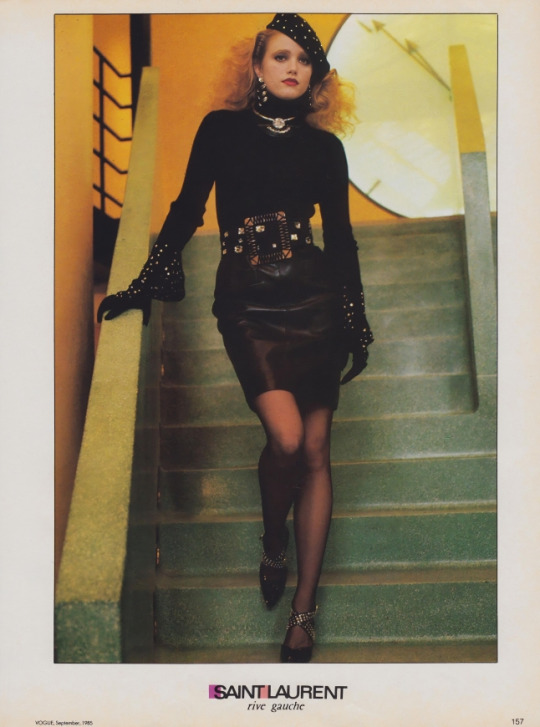
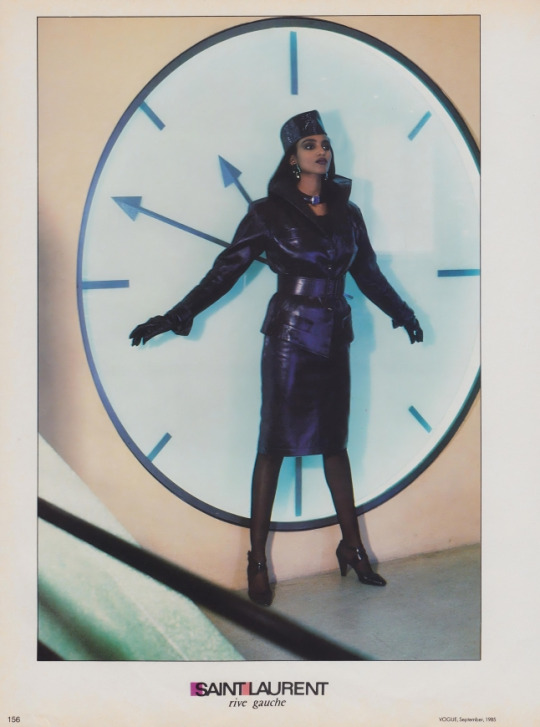
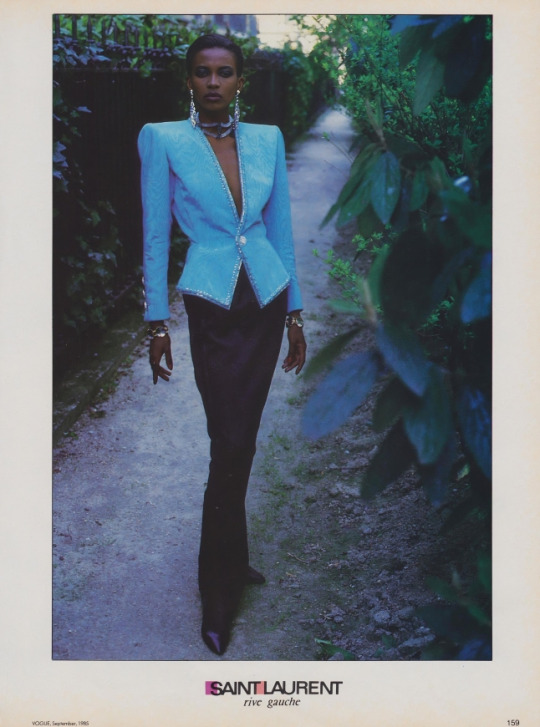
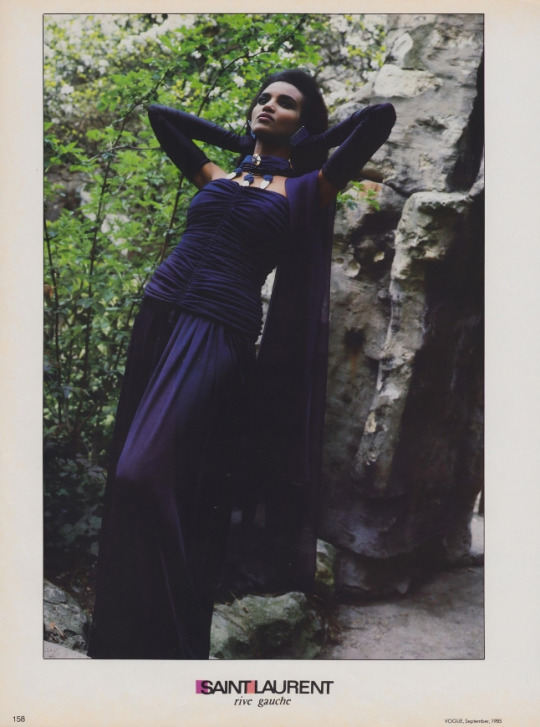
US Vogue September 1985
Saint Laurent Rive Gauche
Models/Modèles : Maria von Hartz, Leticia Lucas, Amalia Vairelli, Khadija Adams.
Makeup/Maquillage José Luis
Photo Helmut Newton
vogue archive
#us vogue#september 1985#fashion 80s#1985-86#fall/winter#automne/hiver#ready to wear#prêt à porter#french designer#french style#ysl#saint laurent rive gauche#maria von hartz#leticia lucas#amalia vairelli#khadija adams#josé luis#helmut newton
33 notes
·
View notes
Text
Understanding the Types of Fashion | Trends and Styles
Fashion is an ever-evolving domain that reflects cultural, social, and historical contexts. It encapsulates a broad spectrum of styles and trends that vary across regions and eras. From haute couture to streetwear, the diversity in fashion styles showcases creativity, individuality, and the human penchant for self-expression. In this blog, we will delve into various types of fashion, exploring their origins, characteristics, and influences.
Haute Couture
Haute couture, translating to "high sewing" or "high dressmaking," is the epitome of luxury fashion. Originating from Paris, it refers to the creation of exclusive, custom-fitted clothing made from the finest materials and with meticulous attention to detail. Designers like Coco Chanel, Christian Dior, and Jean-Paul Gaultier have set the standards for haute couture. Each piece is a work of art, often requiring hundreds of hours of labor. Haute couture is not just about the garment but also about the craftsmanship and the heritage of the fashion house.
Ready-to-Wear (Prêt-à-Porter)
Ready-to-wear fashion bridges the gap between haute couture and mass production. Unlike haute couture, which is made for individual clients, ready-to-wear clothing is produced in standard sizes and available in retail outlets. These collections are often showcased during fashion weeks in major cities like New York, Paris, Milan, and London. Designers like Yves Saint Laurent popularized this type of fashion, making high-quality, stylish clothes accessible to a broader audience.
Streetwear
Streetwear emerged from the urban youth culture of the 1980s and 1990s, heavily influenced by skateboarding, hip-hop, and punk. Characterized by casual, comfortable pieces such as hoodies, sneakers, and graphic T-shirts, streetwear blurs the lines between fashion and everyday wear. Brands like Supreme, Off-White, and A Bathing Ape (BAPE) are iconic in this genre. Streetwear often involves limited edition releases and collaborations with artists and other brands, creating a sense of exclusivity and community.
Vintage and Retro
Vintage fashion refers to clothing and accessories from previous decades, often considered timeless and of high quality. Retro fashion, on the other hand, involves contemporary clothing designed to mimic the style of a previous era. Both styles celebrate nostalgia and the cyclical nature of fashion trends. Vintage shops and thrift stores are treasure troves for unique pieces that tell a story. Designers like Vivienne Westwood have incorporated vintage elements into their collections, blending old and new.
Bohemian (Boho) Fashion
Bohemian fashion, often shortened to "boho," draws inspiration from the free-spirited lifestyle of the 1960s and 1970s hippie movement. Characterized by flowing fabrics, earthy tones, and eclectic patterns, boho fashion exudes a relaxed, unconventional vibe. Key elements include maxi dresses, fringe, embroidery, and ethnic prints. Brands like Free People and Anthropologie have popularized this style, making it a staple for music festivals and casual wear.
Preppy
Preppy fashion is inspired by the traditional clothing styles of American prep schools and Ivy League universities. It is characterized by clean, classic, and polished looks. Key pieces include polo shirts, khaki pants, blazers, and loafers. The style emphasizes quality and timelessness, with brands like Ralph Lauren, Tommy Hilfiger, and Lacoste being quintessential preppy labels. Preppy fashion embodies an understated elegance and a sense of tradition.
Grunge
Grunge fashion originated in the early 1990s, inspired by the Seattle music scene and bands like Nirvana and Pearl Jam. It is characterized by an unkempt, "thrown-together" look, often featuring flannel shirts, ripped jeans, combat boots, and oversized sweaters. The grunge aesthetic is anti-establishment and rejects the polished, mainstream fashion norms. Designers like Marc Jacobs have brought grunge elements to high fashion, blending rebellion with style.
Minimalist
Minimalist fashion focuses on simplicity, clean lines, and a limited color palette. It emphasizes quality over quantity, with a preference for timeless, versatile pieces. Key elements include monochrome outfits, tailored cuts, and understated accessories. Brands like COS, The Row, and Jil Sander exemplify minimalist fashion. The minimalist approach advocates for a more sustainable wardrobe, encouraging thoughtful consumption and investment in enduring pieces.
Avant-Garde
Avant-garde fashion pushes the boundaries of conventional design, embracing innovation, experimentation, and artistic expression. It often features unconventional materials, asymmetrical cuts, and dramatic silhouettes. Avant-garde designers like Alexander McQueen, Rei Kawakubo (of Comme des Garçons), and Issey Miyake create pieces that challenge the norms and provoke thought. This type of fashion is not always about wearability but rather about making a statement and exploring new frontiers.
Athleisure
Athleisure combines athletic and leisurewear, creating a style that is both comfortable and fashionable. It includes items like yoga pants, leggings, sports bras, and sneakers that can be worn for both exercise and everyday activities. This trend reflects the growing emphasis on health, wellness, and the casualization of dress codes. Brands like Lululemon, Nike, and Athleta are pioneers in athleisure, offering functional yet stylish options for the modern, active lifestyle.
Gothic
Gothic fashion draws inspiration from the dark, mysterious aesthetics of gothic literature, architecture, and music. It often features black clothing, lace, velvet, corsets, and Victorian-inspired accessories. The style can range from romantic and elaborate to punk-influenced and industrial. Designers like Alexander McQueen and Rick Owens have incorporated gothic elements into their collections, blending darkness with high fashion.
Punk
Punk fashion emerged in the 1970s as a rebellious statement against the mainstream. It is characterized by DIY elements, distressed fabrics, safety pins, leather jackets, and bold hairstyles like mohawks. Punk fashion is inherently anti-establishment and often incorporates political messages. Designers like Vivienne Westwood played a crucial role in bringing punk aesthetics to the fashion world, merging subculture with haute couture.
Ethnic and Traditional
Ethnic and traditional fashion celebrates cultural heritage and craftsmanship from around the world. It includes clothing and accessories that are specific to a culture or region, such as Indian saris, Japanese kimonos, African Ankara prints, and Native American beadwork. This type of fashion preserves and honors cultural identity while often inspiring contemporary designers to incorporate traditional elements into modern designs.
Business and Formal
Business and formal fashion revolves around professional and sophisticated attire suitable for work environments and formal occasions. Key pieces include tailored suits, blazers, dress shirts, pencil skirts, and formal dresses. Brands like Hugo Boss, Armani, and Brooks Brothers are renowned for their business attire. This type of fashion emphasizes professionalism, confidence, and elegance.
Casual and Everyday
Casual fashion encompasses comfortable and practical clothing for everyday wear. It includes items like jeans, T-shirts, sneakers, and casual dresses. This style prioritizes comfort and ease, making it versatile for various activities. Brands like Levi's, Gap, and Uniqlo are staples in casual fashion, offering timeless pieces that can be dressed up or down.
Sustainable Fashion
Sustainable fashion focuses on environmental and ethical responsibility. It involves using eco-friendly materials, fair trade practices, and promoting slow fashion over fast fashion. Sustainable fashion aims to reduce the negative impact on the planet and improve working conditions in the fashion industry. Brands like Patagonia, Stella McCartney, and Eileen Fisher are leaders in this movement, advocating for a more mindful approach to fashion consumption.
Conclusion
The world of fashion is vast and varied, encompassing a multitude of styles that cater to different tastes, cultures, and occasions. From the opulence of haute couture to the practicality of casual wear, each type of fashion tells a unique story and serves a distinct purpose. Understanding the diversity in fashion not only broadens our sartorial horizons but also deepens our appreciation for the creativity and craftsmanship that define this ever-evolving industry. Whether you gravitate towards the timeless elegance of preppy fashion or the bold statements of avant-garde, there is a style for everyone in the tapestry of fashion.
2 notes
·
View notes
Text

PHOTOSHOOT: INTERVIEW
On March 16th, 2010 Marina Diamandis had an epic photoshoot taken by Sebastian Kim for Interview Magazine.
The styling was done by Sarah Ellison. Hair by Franco Gobbi and makeup by Ozzy Salvatierra. Let's delve!

Even though this small photoshoot comprised only one look, it still gave us everything.
Marina posed in the opening number from Dior's Spring/Summer 2010 prêt-à-porter collection – a beautiful short trench coat rendered in metallic silver silk lamé!

Marina mix-and-matched some cuffs by Alexis Bittar and Anndra Neen. Two of them are Neen's alpaca-silver Cage cuff (€256.95) and Cone brass bangle (€233.95).
Shop:
Anndra Neen "Cage" Cuff (€256.95)
Anndra Neen "Cone" Bangle (€233.95)
4 notes
·
View notes
Text
セクシー・ハラジュク-SEXY HARAJUKU
I want to sexually harass you*
I want to do SEXY HARAJUKU to you
Because in this town, anything at all
Can become stylish, from what I’ve heard
Let me sexually harass you*
Let me do SEXY HARAJUKU to you
Because neither yumekawa or yamiikawa,**
Suit your style at all
All I wanna do is get you worked up
Both what’s in and what’s out,
Are decided by me
Like this city’s rules
All I wanna do is get you wet
It’s purely impure
The way I want to see you is like
This city, laid bare
SEXY HARAJUKU
SEXY HARAJUKU
SEXY HARAJUKU
SEXY HARAJUKU
You wore your underwear like wrapping
Somebody’s present, prêt-à-porter
A scrap that I can’t rap at all
Haute couture that can’t become ecriture
I’ll tear off the wrapping of your underwear
Somebody’s present, like a ready-made
Fast fashion and past fashion
Takenoko*** Nameneko**** in the house!
All I wanna do is get you worked up
What’s trendy and what’s out
Really doesn’t matter, so
Let’s just picture it for now
All I wanna do is get you wet
Purity and sensitivity
Somehow, just like this,
You can't stop it, right?
SEXY HARAJUKU
SEXY HARAJUKU
SEXY HARAJUKU
SEXY HARAJUKU
All I wanna do is get you worked up
If Takeshita Street and
Omotesando*****
Are both erogenous zones,
All I wanna do is get you wet
At Cat Street and
Laforet Hills too*****
I’ll make you cum in style******
SEXY HARAJUKU
SEXY HARAJUKU
SEXY HARAJUKU
SEXY HARAJUKU
SEXY HARAJUKU
SEXY HARAJUKU
SEXY HARAJUKU
SEXY HARAJUKU
I want to sexually harass you*
I want to sexually harass you*
TRANSLATION NOTES
*um. so. セクハラ/sekuhara is short for sexual harassment, and is a commonly used shorthand for it, so really, out of context, this line is “i want to sexually harrass you”, but it also works as shorthand for SEXY HARAJUKU! hence the double entendre of the whole song
**two harajuku fashion trends, literally meaning dreamy cute and dark-cute. they’re cute!
*** refers to Takenokozoku, the name given to a movement of teenagers who’d wear bright flashy outfits and dance in harajuku in the 70’s and 80’s
**** Nameneko was, apparently, a series of extremely popular character goods in the early 80’s that featured pictures of real kittens dressed up as yankees and bosozoku gang members. it also apparently had a revival in popularity recently. this is the most fucked up thing i’ve seen in all my research for this album translation project.
***** these are all places in or near harajuku
****** イカせてあげる is “i’ll make you cum”, but イカす can mean to be cool/stylish, so,
also i just wanted to mention that the MV is a reference to the max headroom incident, which happens to be another special interest of mine, so it makes me super happy:^) tldr guy hijacks a tv station to broadcast his ass getting spanked while wearing a rubber character mask. and temmacore? yes.
4 notes
·
View notes